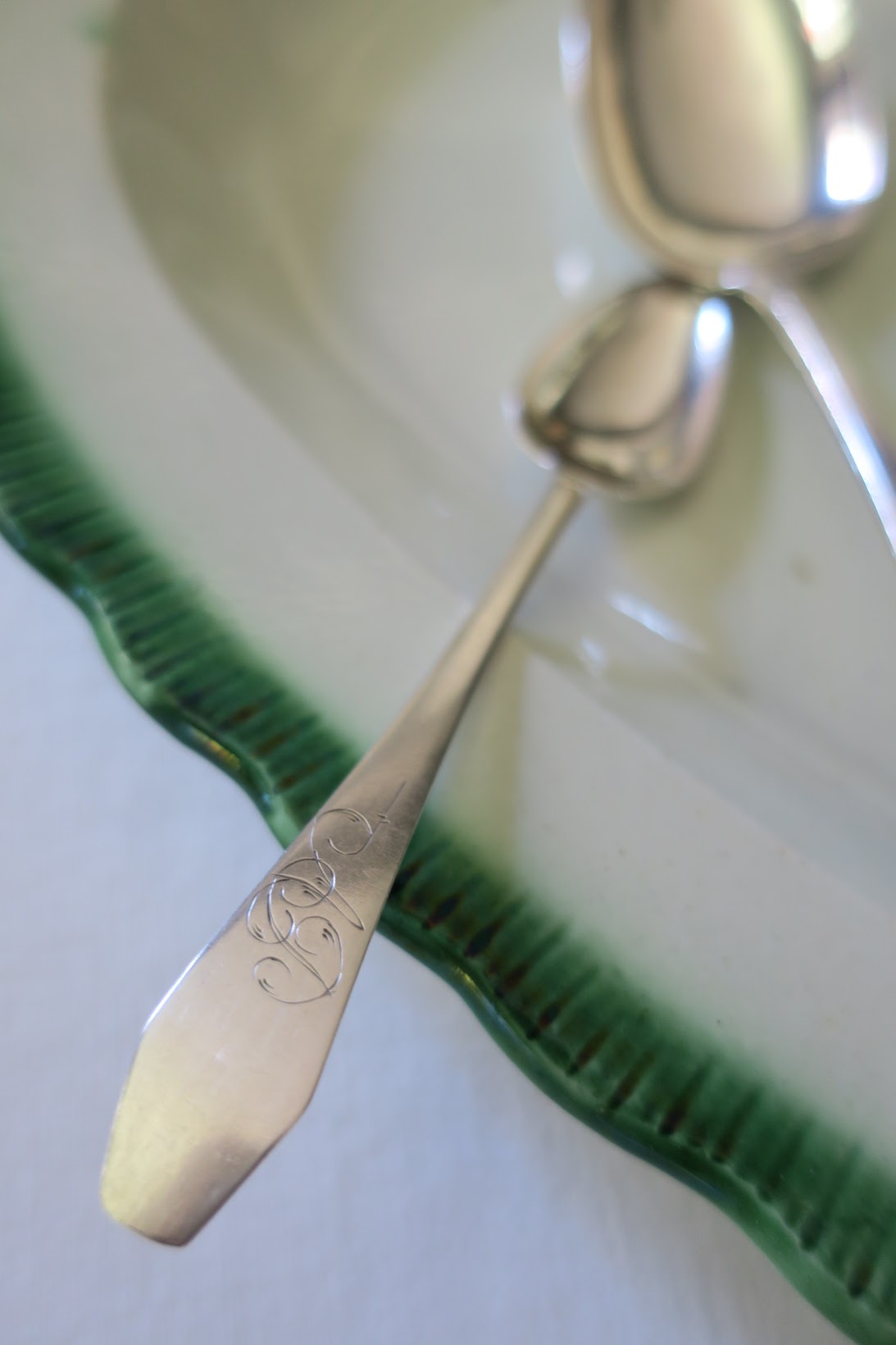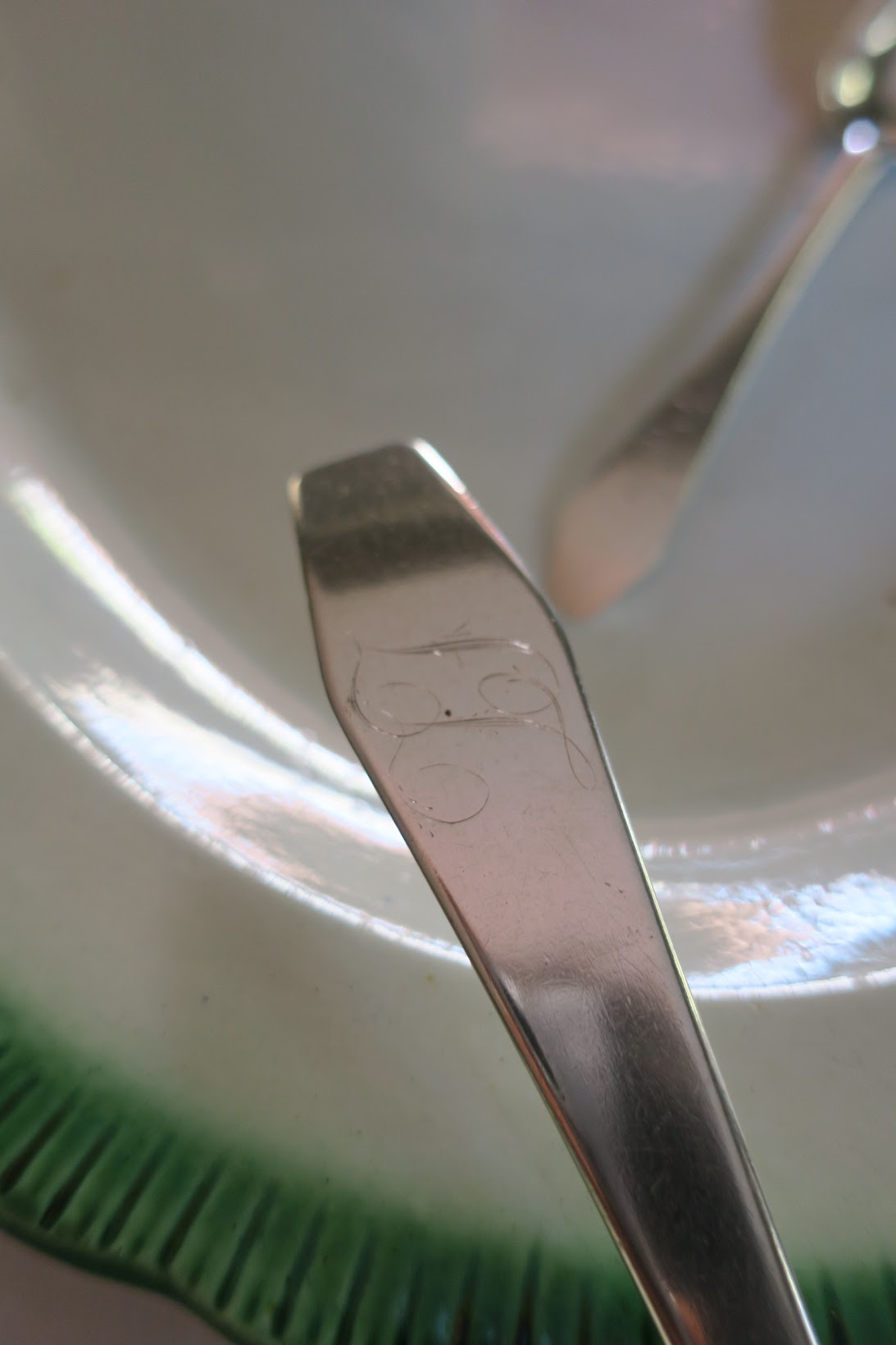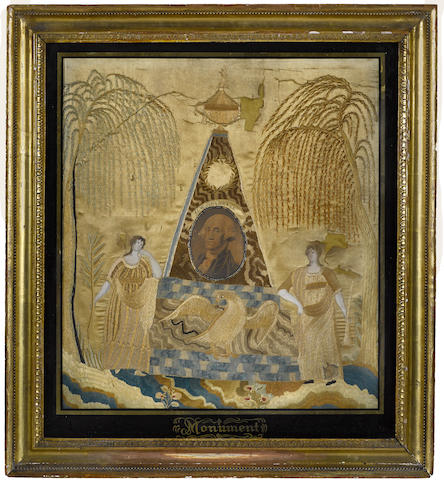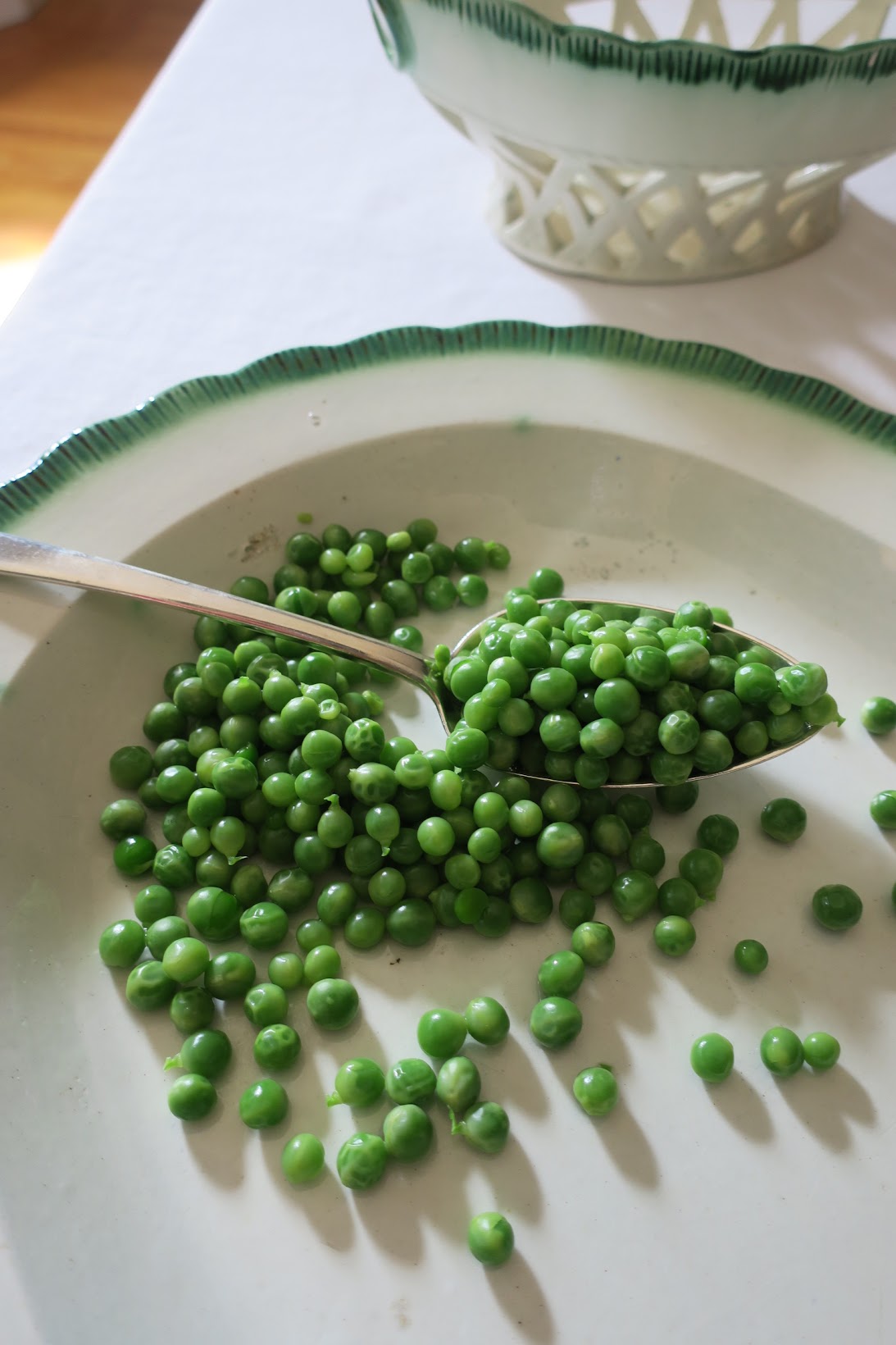As far back as I can recall, I've had an eye - or rather two - for detail. I blame my parents for the affliction, which can be both a blessing and a curse. My father for example, now retired, was highly skilled in his profession as a tailor; details meant the world to him. My parents would actively encourage my sisters and I to observe, compare, and contrast in order to better understand how the smallest detail - be it a button or the cut of a lapel - might add to or detract from the overall appearance of a garment.
The smallest details don't only fascinate me, but can at times become my impetus for telling a story and the lens through which I see a larger picture. Take for example the spoons seen in the photograph below.
At first glance, these two early American coin silver spoons appear to be quite unremarkable. Devoid of decorative detail, aside from a simple monogram, one could easily be forgiven for not offering a second gander. In fact, both the teaspoon and the large serving spoon possess rather a severe aspect to their design. There is a reason for this, and a fascinating one at that.
You see, it is believed that "coffin-end" spoons, as these are called, were fashioned by American silversmiths to commemorate the death of George Washington in 1799. The tip of the spoon's handle was clipped by the silversmith to imply the form of a coffin. This was a design which remained popular until about 1810.
Having culturally attained the honorary title of "Father of His Country", George Washington, America's first president, was largely revered at the time of his death. His passing was felt deeply across the young nation. Many citizens of his newly born nation were so moved as to actually don mourning clothes for months thereafter. As one can imagine, it was not long until all manner of commemorative household goods and artworks appeared to mark this solemn occasion.
I have owned the diminutive coin silver teaspoon for a number of years and acquired it without prior knowledge of any significance to its design. It was much later that I learned about the association of the coffin-end handle and its connection to Washington's death. Naturally, when I saw the large serving spoon for sale at a recent antiques fair, I had to have it.
The dealer from whom I purchased this piece had acquired it as part of a sizable lot of early American silverware assembled by a local professor. The professor had thoughtfully tagged each item with an informative label noting details of the item's origin and year it was made. The preceding photograph shows the label still attached to the serving spoon on the day I purchased it.
As this is a post about a presidential-related item, I thought it would be only fitting to photograph said item on an early green shell-edge pearlware platter. Thomas Jefferson, who followed in George Washington and John Adams' footsteps to become America's third president, utilized this pearlware pattern at Monticello, his mountaintop home in Virginia. Fragments of it have been excavated from the grounds surrounding Monticello's kitchen yard. Today, visitors to Monticello will be delighted to view an entire service of this attractive earthenware laid upon the dining table of the chrome yellow painted dining room.
And, of course, what could one serve from such presidential dining accoutrements? Why, peas of course! Not just any old peas, mind you, but the very same heirloom variety, Pisum sativum 'Prince Albert', selected by Thomas Jefferson to grow within the vegetable garden at Monticello. Some of you may recall the post I wrote in June 2014, found here, on how I came to include these scrumptious peas in my own garden.
I do hope you enjoyed learning about these rather obscure silver spoons and their association with the passing of America's first president, along with revisiting momentarily the dining table of our third. Between these two men, of course, rests much of the reason for such a uniquely American day of celebration, on this fourth day of the seventh month.
Happy Independence Day everyone!
The smallest details don't only fascinate me, but can at times become my impetus for telling a story and the lens through which I see a larger picture. Take for example the spoons seen in the photograph below.
Photo: Chronica Domus
At first glance, these two early American coin silver spoons appear to be quite unremarkable. Devoid of decorative detail, aside from a simple monogram, one could easily be forgiven for not offering a second gander. In fact, both the teaspoon and the large serving spoon possess rather a severe aspect to their design. There is a reason for this, and a fascinating one at that.
You see, it is believed that "coffin-end" spoons, as these are called, were fashioned by American silversmiths to commemorate the death of George Washington in 1799. The tip of the spoon's handle was clipped by the silversmith to imply the form of a coffin. This was a design which remained popular until about 1810.
The distinct shape of this early American coin silver teaspoon tells us that it was fashioned to commemorate the death of George Washington in 1799
Photo: Chronica Domus
A view of the flowing monogram engraved upon the coffin-end handle of the large serving spoon
Photo: Chronica Domus
Having culturally attained the honorary title of "Father of His Country", George Washington, America's first president, was largely revered at the time of his death. His passing was felt deeply across the young nation. Many citizens of his newly born nation were so moved as to actually don mourning clothes for months thereafter. As one can imagine, it was not long until all manner of commemorative household goods and artworks appeared to mark this solemn occasion.
Oh how I kick myself for not bidding on this ink and silk mourning needlework picture when it came up for auction in San Francisco a few years ago - what was I thinking?
I have owned the diminutive coin silver teaspoon for a number of years and acquired it without prior knowledge of any significance to its design. It was much later that I learned about the association of the coffin-end handle and its connection to Washington's death. Naturally, when I saw the large serving spoon for sale at a recent antiques fair, I had to have it.
Article Number 12 in the collection of a local professor was a coffin-end serving spoon made by silversmith Judah Hartt of Middletown, Connecticut in 1800, now happily ensconced in my own collection
Photo: Chronica Domus
The dealer from whom I purchased this piece had acquired it as part of a sizable lot of early American silverware assembled by a local professor. The professor had thoughtfully tagged each item with an informative label noting details of the item's origin and year it was made. The preceding photograph shows the label still attached to the serving spoon on the day I purchased it.
As this is a post about a presidential-related item, I thought it would be only fitting to photograph said item on an early green shell-edge pearlware platter. Thomas Jefferson, who followed in George Washington and John Adams' footsteps to become America's third president, utilized this pearlware pattern at Monticello, his mountaintop home in Virginia. Fragments of it have been excavated from the grounds surrounding Monticello's kitchen yard. Today, visitors to Monticello will be delighted to view an entire service of this attractive earthenware laid upon the dining table of the chrome yellow painted dining room.
Two Washington coffin-end coin silver spoons rest upon a green shell-edge pearlware platter, a pattern favored by Thomas Jefferson at Monticello
Photo: Chronica Domus
And, of course, what could one serve from such presidential dining accoutrements? Why, peas of course! Not just any old peas, mind you, but the very same heirloom variety, Pisum sativum 'Prince Albert', selected by Thomas Jefferson to grow within the vegetable garden at Monticello. Some of you may recall the post I wrote in June 2014, found here, on how I came to include these scrumptious peas in my own garden.
Thomas Jefferson's peas are still growing in my vegetable patch, from seeds gathered after each year's harvest since planting the original package, purchased from Monticello's garden shop in 2012 - this particular addition to our meal was collected early on the morning of June 24 this year
Photo: Chronica Domus
Photo: Chronica Domus
Here are those peas, served upon the same shell-edge pearlware pattern so favored by Thomas Jefferson ...
... and scooped from a commemorative George Washington coffin-end serving spoon
Photo: Chronica Domus
I do hope you enjoyed learning about these rather obscure silver spoons and their association with the passing of America's first president, along with revisiting momentarily the dining table of our third. Between these two men, of course, rests much of the reason for such a uniquely American day of celebration, on this fourth day of the seventh month.
Happy Independence Day everyone!









What a lovely lunch-time read! Your eye for the prize and your flow of the words make for a scrumptious menu for the soul.
ReplyDeleteApropos and wonderfully American on this memorable day.
r
Hello racheld,
DeleteThank you for your lovely comment. I do hope you enjoyed yourself on America's holiday.
I learn so much from you. Happy 4th, we are so glad you're here. xox.
ReplyDeleteHello Lisa,
DeleteHappy 4th to you too on this 5th day of July.
Thank you for these fascinating details into your collectibles. I learn something new every time I visit!
ReplyDeleteI do want to ask about your matching reticulated bowl in the last photos. I've not seen a design like this before, although it looks to be a variation on the fruit bowl, and wondered what its original purpose was and how you use it today?
Greetings from Sydney.
Vanessa
Hello Vanessa,
DeleteThank you for your comment. The early creamware basket was made to hold chestnuts and is a particular favorite piece in my collection. It is often pressed into service as a bread basket and at Easter, I like to cradle a clutch of eggs in it, which rest upon a bed of excelsior. Here is a better photograph of it:
https://chronicadomus.blogspot.com/2016/03/easter-greetings.html?m=1
A chestnut basket? Well, if only the modern household could have the storage space to accommodate the myriad, single-purpose treasures from times past. It does look adorable with your eggs!
DeleteThank you again,
Vanessa
Hello Vanessa,
DeleteAha, don't be fooled! I live in an older house (at least as compared to most others in our area) and we sorely lack adequate cupboard space to stash the (too) many dishes and dining accoutrements we have somehow managed to accumulate. Thank goodness for basements!
Hello CD, How appropriate to match spoon, dish and actual food with the same level of historic interest. I wonder if any serious research has been done on coffin-end tableware, such as researching contemporary inventories to see how they were named. While they indeed coincide with Washington's death, they were also produced quite a bit later, and seem to be part of a lighter, elegant look that came in with the Federal style. In other words, did people of the time see coffins or simply geometric figures in these spoons?
ReplyDelete--Jim
Hello Jim,
DeleteI believe the shape was certainly intended to replicate a coffin but you are correct in that the Federal period enjoyed simpler design. That is why it is my favorite design period for decorative arts.
I would enjoy learning more about these spoons and if any other pieces of cutlery beyond spoons mirrored the coffin-end design.
Lovely and informative as always!
ReplyDeleteWhy thank you, AD. So pleased you found this post informative.
DeleteHow interesting! Peas have never looked more elegant or delectable. I am sure Thomas Jefferson himself would have been pleased to dine at your table.
ReplyDeleteBest,
KL Gaylin
Hello KL Gaylin,
DeleteThomas Jefferson would be a fantasy dinner guest. Would love to pick his brain about the friendly pea growing competitions he enjoyed with his neighboring gentlemen farmer friends.
Clever segues, and I completely understand your interest in detail, and how it is both a blessing and a curse. As an optimist, I'm more inclined to view it as the former; it staggers me how many people can go through life and not see, or have a curiosity about what surrounds them.
ReplyDeleteHello columnist,
DeleteI too am an optimist but those darn details can, at times, drive me nuts. The desire to learn something new each day is what drives me forward, much like a cat I suppose. Hoping I too have nine lives.
Hello again,
ReplyDeleteI just found this post you might be interested in, on the Early American Gardens blog, about Thomas Jefferson's gardening books.
https://americangardenhistory.blogspot.com/2017/07/gardening-books-in-early-america-owned_14.html
Jim
Hello Jim,
DeleteHow kind of you to stop by and provide me with this comprehensive and enviable list of Thomas Jefferson's gardening books. One can only imagine how impressive his collection was in its entirety, before being sold off and scattered to the four winds. I look forward to studying the list over a cup of tea this afternoon, thank you.